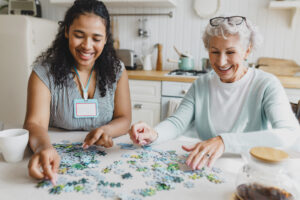If you are presently taking care of an Alzheimer’s patient, then you are a very special person indeed. This role is often filled with challenges, numerous expenses, and hardships. Due to the nature of the illness, victims of Alzheimer’s can be one of the most difficult populations to work with – even if they are a close loved one.
Luckily, there are numerous things you can do to make this important job a little easier, whether you are a caregiver, home health aide, friend, or family member. Read on to see how you can help your senior stay safe and comfortable throughout their daily routine.
Dressing and grooming your senior with Alzheimer’s
The first step in improving an Alzheimer patient’s routine is to establish one in the first place. In fact, this can be done right at the start of the day, when the patient is getting dressed. Dressing at the same time every morning and limiting their clothing to just a few outfits can set up a healthy pattern.
Loose-fitting clothing – preferably of a soft and/or stretchy fabric — will make dressing them easier for you, and wearing the clothes more comfortable for them. If you can obtain pieces that have Velcro instead of zippers, buttons, and more complicated fasteners, then all the better. With regard to shoes: comfortable slip-ons with grips on the bottom will make donning footwear less troublesome, and will also make the senior less likely to trip and fall once the shoes are on.
Be especially gentle when combing their hair and brushing their teeth. If they appear to be in distress or are struggling, it’s all right to take frequent breaks. Make sure to allow for enough time to complete these tasks, and note that it will probably take you longer than normal to do so.
Feeding an Alzheimer’s patient
Did you know that Alzheimer’s can change a person’s eating habits and behaviors? This comes as a surprise to many people when they begin to care for this population. Forgetting how to use utensils and napkins – or even forgetting to eat at all – are all very common, especially in the latter stages of the disease. Your senior may also refuse to eat at times.
But there are several things you can do to making mealtimes less of a battle for you both. First, make sure they have a quiet, distraction-free environment in which to eat. Remember – Alzheimer’s patients are often overwhelmed easily, so even the presence of a TV that’s on may be unwise. Just like dressing, try to serve meals around the same time every day. Don’t serve food or drink that is too hot, and hand-feed them if necessary. Prepare foods they have enjoyed before, but bear in mind these preferences may change over time.
Bathing and the Alzheimer’s patient
Bathing can be one of the hardest aspects about taking care of an Alzheimer’s patient. And it’s no easier on the patient themself, as they may be confused or scared during the process. One way to reduce conflict in this area is to bathe the senior at the time of day when they’re calmest.
Ensure that the water used is warm before they step into it, but obviously not too hot. You can increase the safety of the bathroom area with tools like grab bars, non-slip mats, and a tub or shower bench. If they can understand you, feel free to let them know what you’re doing before you do it, and even encourage them to do a little by themselves. Needless to say, never leave a person with Alzheimer’s unattended in a bathroom by themselves, not even for a minute!
Taking care of an Alzheimer’s patient has its rewards
Taking care of Alzheimer’s patients can be time-consuming, frustrating, and sometimes heartbreaking. However, it can also be rewarding. When you care for someone whose capabilities and perhaps personality are gone, you learn how to be compassionate and live with grace. And when you make the most of the time they have left, you offer a special gift to the world – and to yourself.
If you are unsure of how to best help an aging loved one, the trained and compassionate staff at the Institute on Aging is here to help you make that decision and gain the best in at-home senior care. Contact us to find out more.







